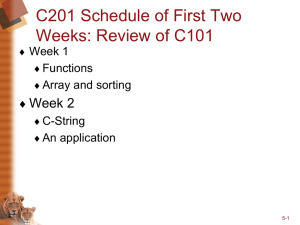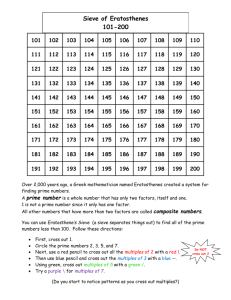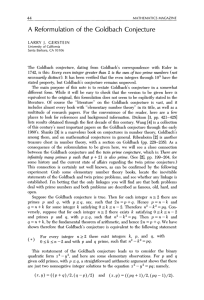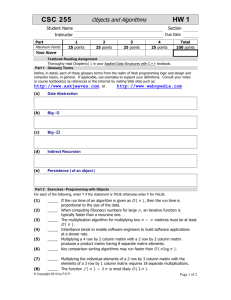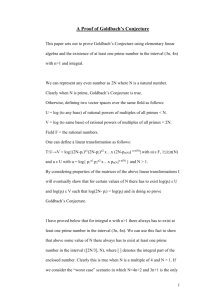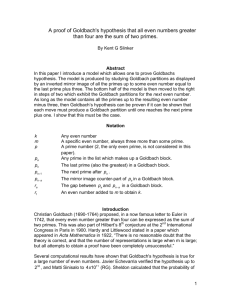`where maths meets fiction`
advertisement
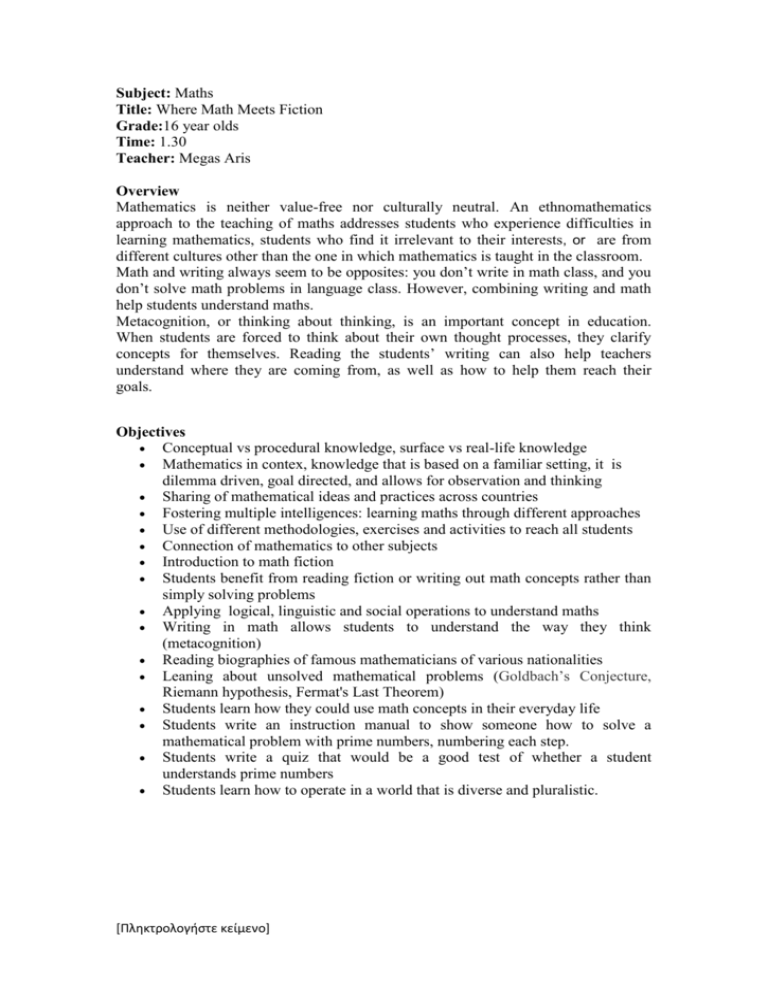
Subject: Maths Title: Where Math Meets Fiction Grade:16 year olds Time: 1.30 Teacher: Megas Aris Overview Mathematics is neither value-free nor culturally neutral. An ethnomathematics approach to the teaching of maths addresses students who experience difficulties in learning mathematics, students who find it irrelevant to their interests, or are from different cultures other than the one in which mathematics is taught in the classroom. Math and writing always seem to be opposites: you don’t write in math class, and you don’t solve math problems in language class. However, combining writing and math help students understand maths. Metacognition, or thinking about thinking, is an important concept in education. When students are forced to think about their own thought processes, they clarify concepts for themselves. Reading the students’ writing can also help teachers understand where they are coming from, as well as how to help them reach their goals. Objectives Conceptual vs procedural knowledge, surface vs real-life knowledge Mathematics in contex, knowledge that is based on a familiar setting, it is dilemma driven, goal directed, and allows for observation and thinking Sharing of mathematical ideas and practices across countries Fostering multiple intelligences: learning maths through different approaches Use of different methodologies, exercises and activities to reach all students Connection of mathematics to other subjects Introduction to math fiction Students benefit from reading fiction or writing out math concepts rather than simply solving problems Applying logical, linguistic and social operations to understand maths Writing in math allows students to understand the way they think (metacognition) Reading biographies of famous mathematicians of various nationalities Leaning about unsolved mathematical problems (Goldbach’s Conjecture, Riemann hypothesis, Fermat's Last Theorem) Students learn how they could use math concepts in their everyday life Students write an instruction manual to show someone how to solve a mathematical problem with prime numbers, numbering each step. Students write a quiz that would be a good test of whether a student understands prime numbers Students learn how to operate in a world that is diverse and pluralistic. [Πληκτρολογήστε κείμενο] Materials copies of the novel ‘Uncle Petros and Goldbach’s Conjecture’(2000) by Apostolos Doxiadis. Bloomsbury, New York, 2000. Hardcover, 208 pp., ISBN 1582340676. student notebooks black board computers with Internet access Methodology research discussion group work reflective inquiry problem solving Process Warm-up: Students answer the following questions: 1. When you are struggling to do a math problem, how do you feel? What process do you use until you are finally successful? 2. When you get a math problem wrong (and everyone does sometimes), what is your reaction? How would you like to react? 3. Math is fun: agree or disagree? Discuss your answer. 4. What is the most interesting math skill you have ever learned? Was it relevant to your life? 5. What are your strengths and weaknesses? 6. What is your dream? What would happen if you didn't achieve it? Pre-reading tasks Ask students the following guided reading questions: How did Apostolos Doxiadis apply ‘Goldbach’s Conjecture’ to writing? What is Goldbach’s conjecture? Why is it important? Why have Goldbach become increasingly popular? How can you apply what you read in ‘Uncle Petros and Goldbach’s Conjecture’ novel to use math concepts in your everyday life? Activity 1 Distribute copies of the novel ‘Uncle Petros and Goldbach’s Conjecture’(2000) by Apostolos Doxiadis. Ask them to read the introduction and explain the words below: VOCABULARY: genius, conjecture, solitary eccentric, at the cost of his sanity, esteemed professor QUICK DEBATE: [Πληκτρολογήστε κείμενο] Students A thinks ‘Being a Genius Is Due to Hard Work, Not High IQ’ Students B thinks ‘In fact, some geniuses have average IQ’ Change partners often. Share your findings. BEING A GENIUS: Match the two halves of the statements below to make quotations about geniuses. 1. 2. 3. 4. 5. A genius is one who can Great geniuses have the shortest biographies. Oh! how near are genius Talent, lying in the understanding, is often inherited; Genius is not so much about new ideas a. b. c. d. e. genius, being the action of reason or imagination, rarely or never. do anything except make a living. and madness! as it is about clarity of ideas. Their cousins can tell you nothing about them. GENIUS: In pairs, spend one minute writing down all of the different words you associate with geniuses. Share your words with your partner(s) and talk about them. INTERNET RESEARCH: Go to the link below with biographies of famous mathematicians. Find and read information about Euclides, Goldbach, Leonard Euler, G.H. Hardy, Srinivasa Romanujan, Kurt Gödel. Where are they from? Did you read any similar things about them? http://www-history.mcs.st-andrews.ac.uk/history/BiogIndex.html Activity 2 Pre-reading tasks A. Ask the students the following guided reading question: 1. 2. 3. 4. Did you ever want to send a message that only your friend can read? Did you want to try and crack a secret message from someone else? What do you know about codes? Where are they used? B. Give students information about prime numbers and Goldbach’s Conjecture. Goldbach's conjecture is one of the oldest unsolved problems in number theory and mathematics. It states: every even number is the sum of two primes A prime number is any number greater than 1 which has as its only divisors 1 and itself. Thus 5 is prime because its only divisors are 1 and 5. Similarly 7, 11, and 13 are prime as well; 2 is the only even prime. Euclid was the first to show that the prime numbers formed an infinite set, then this means that there are as many primes as all the counting numbers, hard as that might be to believe! Two of the most famous unsolved problems in mathematics deal directly or indirectly with prime numbers: the Riemann Hypothesis and the Goldbach Conjecture. [Πληκτρολογήστε κείμενο] People continue to this day in the search of ever larger prime numbers. The largest prime discovered to date was found in 2006 by two professors, and has almost ten million digits! But outside pure mathematical interest, what is the point of all this fascination with finding larger and larger primes? Well that’s where cryptography comes in and the idea of internet commerce. Prime numbers found little practical value until about the 1970's when public key cryptography was discovered. This procedure allows information to be coded so that only the person who knows the secret key can decipher the message. This protocol allows private information to be sent over the internet securely without the fear of such being intercepted and read by somebody for whom the information is not intended. This methodology allows us to conduct secure banking and financial transactions over the internet today. This type of cryptography depends on prime numbers—very large prime numbers! The entire security of the Internet and much desktop computing is based on the PKI, or Public Key Infrastructure. This allows two users, or machines, who have never met before to establish secure communication without any real possibility that a third party can eavesdrop. Essentially, the theory behind this field hinges on the inherent difficulty of factoring the product of two very large prime numbers without knowing one of the primes. Thus by using the theory of prime numbers, cryptographers can encode sensitive data and thereby permit secure transactions over a public network like the internet. And the bigger the prime numbers, the harder it is to crack the code. Thus the search for ever bigger primes. There are a number of ways an even number can be represented as the sum of two primes. Expressing a given even number as a sum of two primes is called a Goldbach partition of the number. For example, 4=2+2 6=3+3 8=3+5 10 = 7 + 3 or 5 + 5 12 = 5 + 7 20=13+7 or 20=17+3 14 = 3 + 11 o= 7 + 7 42=23+19 = 29+3=31+11=37+5 C. Tell students how ‘The Sieve of Eratosthenes’ works The Sieve of Eratosthenes Eratosthenes (275-194 B.C., Greece) devised a 'sieve' to discover prime numbers. A sieve is like a strainer that you use to drain spaghetti when cooking is done. The water drains out, leaving your spaghetti behind. Eratosthenes's sieve drains out composite numbers and leaves prime numbers behind. To use the sieve of Eratosthenes to find the prime numbers up to 100, make a chart of the first one hundred positive integers (1-100): 1 11 21 31 41 51 61 71 81 91 2 3 4 5 6 12 13 14 15 22 23 24 25 32 33 34 35 42 43 44 45 52 53 54 55 62 63 64 65 72 73 74 75 82 83 84 85 92 93 94 95 [Πληκτρολογήστε κείμενο] 7 16 26 36 46 56 66 76 86 96 8 9 10 17 18 19 20 27 28 29 30 37 38 39 40 47 48 49 50 57 58 59 60 67 68 69 70 77 78 79 80 87 88 89 90 97 98 99 100 1. Cross out 1, because it is not prime. 2. Circle 2, because it is the smallest positive even prime. Now cross out every multiple of 2; in other words, cross out every second number. 3. Circle 3, the next prime. Then cross out all of the multiples of 3; in other words, every third number. Some, like 6, may have already been crossed out because they are multiples of 2. 4. Circle the next open number, 5. Now cross out all of the multiples of 5, or every 5th number. Continue doing this until all the numbers through 100 have either been circled or crossed out. You have just circled all the prime numbers from 1 to 100! D. Exercises Give students the following numbers 6, 16, 26, 36, 46, 56, 66, 76, 86, 96 For each of these numbers the students should find two prime numbers whose sum is the number, e.g 6=3+3 16=13+3 Suppose that n is one of these numbers. Think if n can be written as n=(n-3)+3 with n-3, 3 prime numbers Notice that there can be more than one Goldbach pair. The conjecture says only that there is at least one, and has nothing to say about whether there may be more. E. Give students some additional information about Goldbach’s Conjencture in popular culture. To generate publicity for the novel Uncle Petros and Goldbach's Conjecture by Apostolos Doxiadis, British publisher Tony Faber offered a $1,000,000 prize if a proof was submitted before April 2002. The prize was never claimed. The television drama Lewis featured a mathematics professor who had won the Fields medal for his work on Goldbach's conjecture. Isaac Asimov's short story "Sixty Million Trillion Combinations" featured a mathematician who suspected that his work on Goldbach's conjecture had been stolen. In the Spanish movie La habitación de Fermat (2007), a young mathematician claims to have proved the conjecture. [Πληκτρολογήστε κείμενο] A reference is made to the conjecture in the film The Beast with a Billion Backs, in which multiple elementary proofs are found in a Heaven-like scenario. EVALUATION: You could assess each student's comprehension by having them write responses to the questions mentioned in this lesson. HOMEWORK Write a math (auto)biography – or a history of your feelings about math. Include your first memories about math, any math classes that affected how you feel about math, and your current feelings about math. What were your best and worst experiences with math? (Verbal-linguistic intelligence) Write about a subject you are learning in math class. What do you think about it? Do you find it easy or hard? Do you think it will be useful in the real world? (existential intelligence) Go to the link below and play some games with secret codes and messages (kinesthetic intelligence). http://cryptoclub.math.uic.edu/indexmain.html Search the Internet to find information about Goldbach’s Conjencture in popular culture as referred in activity 2.E References http://www.apostolosdoxiadis.com/en/index.php http://www-history.mcs.st-andrews.ac.uk/history/BiogIndex.html http://www.amazon.com/Petros-Goldbachs-Conjecture-ApostolosDoxiadis/dp/1582340676#reader_1582340676 http://www.maa.org/reviews/petros.html [Πληκτρολογήστε κείμενο] [Πληκτρολογήστε κείμενο]

